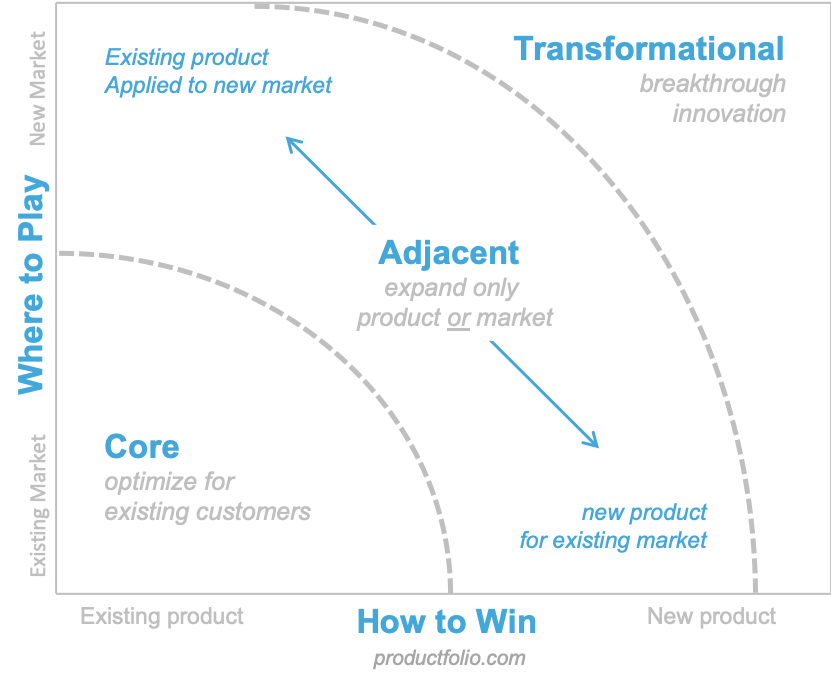What is the Innovation Ambition Matrix?
Everything in our economy and with our technology is changing faster than ever. What was once innovative and differentiating becomes commonplace in time and the saying “the only constant is change” is truer than ever. Part of Product lifecycle planning is thinking about how to continue creating value and so it’s helpful to have a framework to guide thought on how to do so with an already established product.
The Innovation Ambition Matrix is an instant play game that is based on a 2012 article, “Managing Your Innovation Portfolio”, written by Bansi Nagji and Geoff Tuff in the Harvard Business Review. The goal of this game is to organize initiatives and goals to create a strategy that is based on three levels; core, adjacent and transformational. The graph has an X-axis, a Y-axis and three sections to organize ideas. The X-axis represents the product that you are creating. The Y-axis represents the market that you are selling your product to.

To play the game team members place their ideas on the area of the chart that best represents their idea by category. The game can be played digitally with team members, or it can be drawn on a whiteboard and team members can use stickies, creating a visual for everyone to see.
Innovation Matrix in Detail
Now that we have a basic understanding of how to play the game with your team, let’s look at what each respective area of the chart represents.
- Core – Core on the X-axis promotes using existing products. On the Y-axis, Core represents serving the current market.
- Adjacent – Adjacent on the X-axis represents adding products incrementally. On the Y-axis it represents a product entering into an adjacent market.
- Transformational – Transformation on the X-axis represents developing new products. On the Y-axis it represents a product entering into a new market.
Once the team has contributed all of their ideas to the board, you will have a visual that indicates a vision for where the team feels the products new direction should be. The board helps every one to get on the same page with the new goal and encourages the innovation of a new or existing product.
Strategy by the numbers
In the Harvard Business Review article by Nagji and Tuff they discuss striking the right balancing statistically. According to their research in the industrial, technology and consumer goods sector, certain percentages significantly outperform the others. What they found was that companies that allocated approximately 70% of their innovation activity to core initiatives, 20% to adjacent initiatives, and 10% to transformational initiatives saw a greater success rate than their competitors with different percentages in the respective categories.
The 70-20-10 ratio strikes a healthy balance between short term predictable growth and long term bets. The 70- 20 -10 is not always a tried and true statistic, the right balance will vary based on the product and the market. The goal is to keep innovation in mind. Humans are creatures of habit and of comfort. Injecting a method or game into your workflow that encourages everyone to get out of the comfort zone and to keep their minds sharp and thinking about innovation will keep a product relevant in the marketplace.
In conclusion, the Innovation Matrix is a game that can be fun for the whole team, it creates a visual so that everyone can see where the product is going, and it encourages growth, innovation, and change. Setting scheduled time tables to introduce the game into the lifetime of a product can help the product to stay relevant in the marketplace.